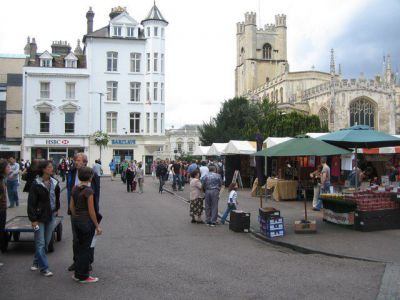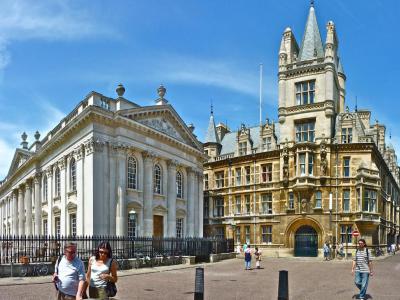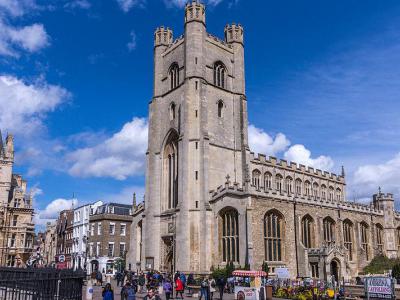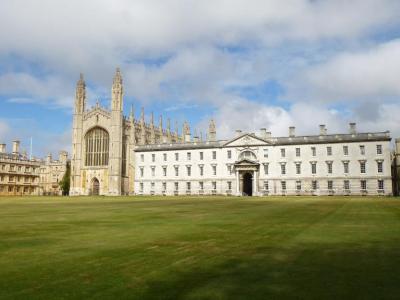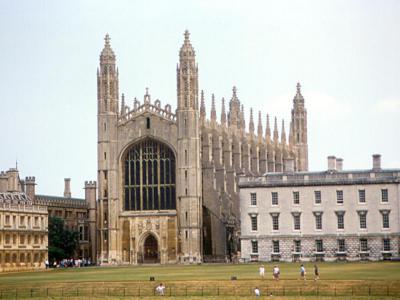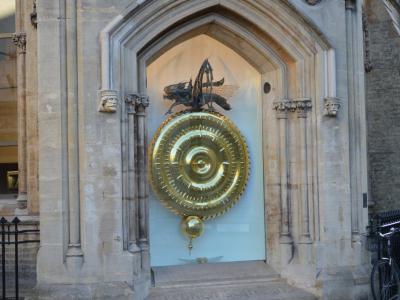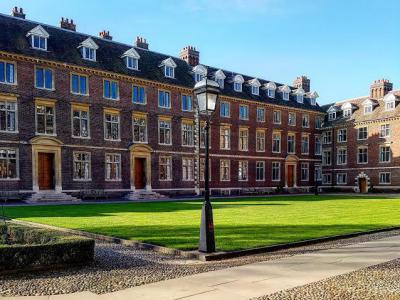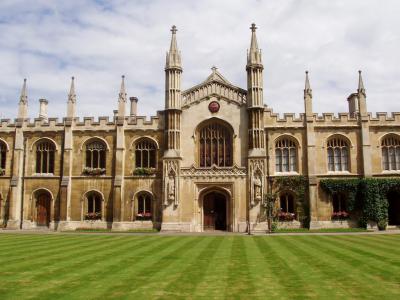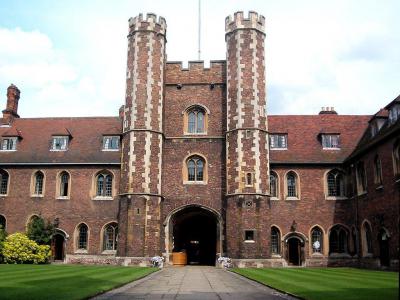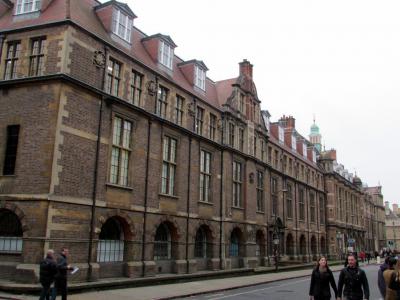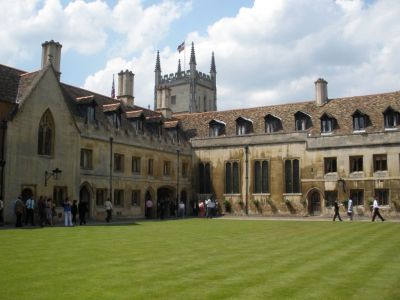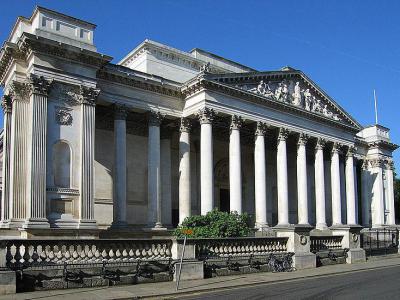Cambridge Introduction Walking Tour (Self Guided), Cambridge
Set along the banks of the River Cam in one of the picturesque eastern shires of England, Cambridge is a place that exudes an air of academic excellence and historical charm. For those not particularly well-versed in the annals of English history, Cambridge holds a prominent spot as one of the country's most esteemed academic hubs. The University of Cambridge consistently ranks among the world's top universities.
This idyllic town has evolved from humble origins back in Roman times. The Anglo-Saxons settled the area by the 5th century AD, establishing a village called "Granta Brycge," which means "Bridge over the River Granta." Later, the name evolved into "Cambridge," meaning a passage or ford.
The town's strategic location along trade routes across the fenlands contributed to its growth, which was further enhanced by the Vikings' arrival in the late 9th century. The Norman era brought William the Conqueror's castle on Castle Hill in 1068. During Henry I's reign, the city received its first charter.
Cambridge University, founded in 1209, became a sanctuary for scholars fleeing persecution from Oxford. Subsequently, new colleges like Gonville Hall, Trinity Hall, Corpus Christi, and Clare arose. The construction of King's College Chapel, a symbol of Cambridge, commenced in 1446.
During the English Civil War, Cambridge played a significant role as the headquarters of the Parliamentarian military force. Oliver Cromwell, educated at local Sidney Sussex College, took control in 1643.
The 19th century brought rapid expansion to Cambridge due to the arrival of the railway in 1845, which continued through the mid-20th century. During World War II, Cambridge played a vital role in defending Britain's east coast, serving as a military center and an evacuation center for Londoners.
While the University and affiliated colleges make up the bulk of Cambridge sights, the town boasts a wealth of ecclesiastical treasures too, including the magnificent Great Saint Mary's Church, a towering edifice that has graced the skyline for over 400 years.
Intriguingly, Cambridge also plays host to modern marvels such as the Corpus Clock.
For those with a penchant for the sciences, the Sedgwick Museum of Earth Sciences offers a captivating journey through geological time, while art enthusiasts will find solace in the Fitzwilliam Museum.
Today, Cambridge remains a beacon of learning, culture, and history, welcoming visitors from around the world to explore its rich heritage and academic legacy. Come and discover the allure of this historic town for yourself on this self-guided walk – a journey both intellectually and culturally enriching!
This idyllic town has evolved from humble origins back in Roman times. The Anglo-Saxons settled the area by the 5th century AD, establishing a village called "Granta Brycge," which means "Bridge over the River Granta." Later, the name evolved into "Cambridge," meaning a passage or ford.
The town's strategic location along trade routes across the fenlands contributed to its growth, which was further enhanced by the Vikings' arrival in the late 9th century. The Norman era brought William the Conqueror's castle on Castle Hill in 1068. During Henry I's reign, the city received its first charter.
Cambridge University, founded in 1209, became a sanctuary for scholars fleeing persecution from Oxford. Subsequently, new colleges like Gonville Hall, Trinity Hall, Corpus Christi, and Clare arose. The construction of King's College Chapel, a symbol of Cambridge, commenced in 1446.
During the English Civil War, Cambridge played a significant role as the headquarters of the Parliamentarian military force. Oliver Cromwell, educated at local Sidney Sussex College, took control in 1643.
The 19th century brought rapid expansion to Cambridge due to the arrival of the railway in 1845, which continued through the mid-20th century. During World War II, Cambridge played a vital role in defending Britain's east coast, serving as a military center and an evacuation center for Londoners.
While the University and affiliated colleges make up the bulk of Cambridge sights, the town boasts a wealth of ecclesiastical treasures too, including the magnificent Great Saint Mary's Church, a towering edifice that has graced the skyline for over 400 years.
Intriguingly, Cambridge also plays host to modern marvels such as the Corpus Clock.
For those with a penchant for the sciences, the Sedgwick Museum of Earth Sciences offers a captivating journey through geological time, while art enthusiasts will find solace in the Fitzwilliam Museum.
Today, Cambridge remains a beacon of learning, culture, and history, welcoming visitors from around the world to explore its rich heritage and academic legacy. Come and discover the allure of this historic town for yourself on this self-guided walk – a journey both intellectually and culturally enriching!
How it works: Download the app "GPSmyCity: Walks in 1K+ Cities" from Apple App Store or Google Play Store to your mobile phone or tablet. The app turns your mobile device into a personal tour guide and its built-in GPS navigation functions guide you from one tour stop to next. The app works offline, so no data plan is needed when traveling abroad.
Cambridge Introduction Walking Tour Map
Guide Name: Cambridge Introduction Walking Tour
Guide Location: England » Cambridge (See other walking tours in Cambridge)
Guide Type: Self-guided Walking Tour (Sightseeing)
# of Attractions: 12
Tour Duration: 2 Hour(s)
Travel Distance: 1.8 Km or 1.1 Miles
Author: sylvia
Sight(s) Featured in This Guide:
Guide Location: England » Cambridge (See other walking tours in Cambridge)
Guide Type: Self-guided Walking Tour (Sightseeing)
# of Attractions: 12
Tour Duration: 2 Hour(s)
Travel Distance: 1.8 Km or 1.1 Miles
Author: sylvia
Sight(s) Featured in This Guide:
- Market Hill
- Gonville and Caius College
- Great St. Mary's Church
- King's College
- King's College Chapel
- Corpus Clock
- St Catharine's College
- Corpus Christi College
- Queens' College
- Sedgwick Museum of Earth Sciences
- Pembroke College
- Fitzwilliam Museum
1) Market Hill
Market Hill, commonly referred to as Market Square, is a notable 203-metre-long street situated in the heart of Cambridge. This historic area serves as the center of daily commerce with an outdoor market that traces its origins back to Saxon times. The market offers a diverse array of products, ranging from clothing and books to fresh fruits, vegetables, second-hand bikes, and mobile phone accessories.
The square has a rich historical backdrop, notably during the Peasants' Revolt in 1381. A significant event occurred when a mob, led by the Mayor of Cambridge and incited by Margery Starre, destroyed the university's ledgers in the square. This act of rebellion was marked by a dance and the defiant cry "Away with the learning of clerks, away with it!"
Originally, Market Hill was densely built up with structures until a transformative fire in 1849 led to the clearance of these buildings. The redevelopment of the square included the addition of a Gothic Revival gabled fountain in 1855, though most of it was demolished in 1953, and its water supply was permanently severed in 1960 due to nearby construction activities.
Today, Market Hill is flanked by significant landmarks. To the west lies Great Saint Mary's, the Cambridge University Church, famous for its towering presence on King's Parade. On the southern edge, the Cambridge Guildhall stands, a structure built in the 1930s. Nearby, the Grand Arcade and Lion Yard shopping centers provide modern shopping experiences, blending the historical with the contemporary in the heart of Cambridge.
The square has a rich historical backdrop, notably during the Peasants' Revolt in 1381. A significant event occurred when a mob, led by the Mayor of Cambridge and incited by Margery Starre, destroyed the university's ledgers in the square. This act of rebellion was marked by a dance and the defiant cry "Away with the learning of clerks, away with it!"
Originally, Market Hill was densely built up with structures until a transformative fire in 1849 led to the clearance of these buildings. The redevelopment of the square included the addition of a Gothic Revival gabled fountain in 1855, though most of it was demolished in 1953, and its water supply was permanently severed in 1960 due to nearby construction activities.
Today, Market Hill is flanked by significant landmarks. To the west lies Great Saint Mary's, the Cambridge University Church, famous for its towering presence on King's Parade. On the southern edge, the Cambridge Guildhall stands, a structure built in the 1930s. Nearby, the Grand Arcade and Lion Yard shopping centers provide modern shopping experiences, blending the historical with the contemporary in the heart of Cambridge.
2) Gonville and Caius College
Gonville and Caius College is one of the oldest and most influential colleges within Cambridge University. Both Oxford and Cambridge Universities, Britain’s two most prestigious places of learning, are made up of affiliate colleges, such as Gonville and Caius. First established in 1348, the college is the fourth-oldest at the University of Cambridge and one of the wealthiest. It owes much of its success and development to the two men who give the college its name – despite the fact they lived two centuries apart. William Gonville founded the college but died three years later. Gonville Hall, as it was then known, moved to its present site shortly afterwards.
John Caius took over the running of the dilapidated college building in 1559, renaming it Gonville and Caius College. He restored and extended the buildings and created the elegant courtyards that still stand today, including Caius Court. Master of the college for 15 years, Caius was renowned for his unusual entry rules, barring the sick and infirm, as well as the Welsh, from studying here. While this rule has thankfully been abandoned, Gonville & Caius is still known for its strong traditions. Meals are eaten communally in the dining hall, often whilst wearing formal gowns. Specialising in sciences, particularly medicine, the college has several famous alumni, including Sir Stephen Hawking and broadcaster Sir David Frost. The college has been attended by many students who have gone on to significant accomplishment, including fourteen Nobel Prize winners, the second-most of any Oxbridge college (after Trinity College, Cambridge).
Why You Should Visit:
To enter and roam around the intimate, peaceful grounds and chapel – and you can do that for no charge.
Tip:
For around £50 you can sleep in an admittedly basic and ancient traditional room in one of the old courts of the main college. You may be woken earlier than you intended by the bells of the adjacent Great St Mary's Church. Included is a full English breakfast in the old hall, lined with paintings of former masters and of Stephen Hawking, the theoretical physicist.
John Caius took over the running of the dilapidated college building in 1559, renaming it Gonville and Caius College. He restored and extended the buildings and created the elegant courtyards that still stand today, including Caius Court. Master of the college for 15 years, Caius was renowned for his unusual entry rules, barring the sick and infirm, as well as the Welsh, from studying here. While this rule has thankfully been abandoned, Gonville & Caius is still known for its strong traditions. Meals are eaten communally in the dining hall, often whilst wearing formal gowns. Specialising in sciences, particularly medicine, the college has several famous alumni, including Sir Stephen Hawking and broadcaster Sir David Frost. The college has been attended by many students who have gone on to significant accomplishment, including fourteen Nobel Prize winners, the second-most of any Oxbridge college (after Trinity College, Cambridge).
Why You Should Visit:
To enter and roam around the intimate, peaceful grounds and chapel – and you can do that for no charge.
Tip:
For around £50 you can sleep in an admittedly basic and ancient traditional room in one of the old courts of the main college. You may be woken earlier than you intended by the bells of the adjacent Great St Mary's Church. Included is a full English breakfast in the old hall, lined with paintings of former masters and of Stephen Hawking, the theoretical physicist.
3) Great St. Mary's Church (must see)
Great Saint Mary's is a Church of England parish and university church situated at the north end of King's Parade in central Cambridge. Designated as a Grade I listed building by Historic England, it holds significant historical and architectural value.
As the university church for the University of Cambridge, Great Saint Mary's plays an integral role in the university's legislative framework. This includes residency requirements for university officers and undergraduates relative to the church's location. The church is instrumental in university life, hosting University Sermons, and housing both the University Organ and the iconic University Clock, which chimes the "Cambridge Quarters" that inspired the Big Ben chimes.
The historical records of Great Saint Mary's date back to 1205 when King John presented Thomas de Chimeleye to the rectory. The church's foundations likely date to 1010, though it underwent reconstruction following a destructive fire on July 9, 1290. Initially known as The Church of Saint Mary the Virgin until 1352, it has since been referred to by its current name. The crown initially held the church's patronage, which was transferred to King's Hall in 1342.
Architecturally, the church is styled in the Late Perpendicular motif, with stained glass work completed by Hardman between 1867 and 1869. To manage large audiences during compulsory University Sermons, galleries were added in 1735. The church boasts several unique features, including one of the few moveable pulpits in England, a font from 1632, and a significant sculpture of Christ in Majesty by Alan Durst completed in 1960.
The church's bell history is notable as well, with the bells initially housed in a wooden structure before being moved to the tower in 1515. The Society of Cambridge Youths, formed in 1724 to oversee the ringing, is recognized as one of the oldest bellringing societies.
Great Saint Mary's also contains two distinct pipe organs-the Parish Organ in the Chancel and the University Organ in the West Gallery, the latter owned by the university. The University Organ, built originally in 1698 by Bernard Smith and significantly enhanced over the centuries, serves as a focal point for university services.
Today, Great Saint Mary's continues to serve both its parish and the academic community, aligning with the Liberal Catholic tradition of the Church of England and embracing inclusive practices as a member of the Inclusive Church network.
Why You Should Visit:
As well as viewing the beautiful nave, you can climb the bell tower (admission fee) to the viewing platform for a spectacular panorama of the city.
Tip:
The acoustics here are excellent for concerts (watch for a schedule) and be sure to check out the first edition King James Bible, on the left-hand side, as you enter the church.
If you climb the tower, try to be the first in your group and go up quickly (very narrow stairs), so you have one minute alone on the top.
As the university church for the University of Cambridge, Great Saint Mary's plays an integral role in the university's legislative framework. This includes residency requirements for university officers and undergraduates relative to the church's location. The church is instrumental in university life, hosting University Sermons, and housing both the University Organ and the iconic University Clock, which chimes the "Cambridge Quarters" that inspired the Big Ben chimes.
The historical records of Great Saint Mary's date back to 1205 when King John presented Thomas de Chimeleye to the rectory. The church's foundations likely date to 1010, though it underwent reconstruction following a destructive fire on July 9, 1290. Initially known as The Church of Saint Mary the Virgin until 1352, it has since been referred to by its current name. The crown initially held the church's patronage, which was transferred to King's Hall in 1342.
Architecturally, the church is styled in the Late Perpendicular motif, with stained glass work completed by Hardman between 1867 and 1869. To manage large audiences during compulsory University Sermons, galleries were added in 1735. The church boasts several unique features, including one of the few moveable pulpits in England, a font from 1632, and a significant sculpture of Christ in Majesty by Alan Durst completed in 1960.
The church's bell history is notable as well, with the bells initially housed in a wooden structure before being moved to the tower in 1515. The Society of Cambridge Youths, formed in 1724 to oversee the ringing, is recognized as one of the oldest bellringing societies.
Great Saint Mary's also contains two distinct pipe organs-the Parish Organ in the Chancel and the University Organ in the West Gallery, the latter owned by the university. The University Organ, built originally in 1698 by Bernard Smith and significantly enhanced over the centuries, serves as a focal point for university services.
Today, Great Saint Mary's continues to serve both its parish and the academic community, aligning with the Liberal Catholic tradition of the Church of England and embracing inclusive practices as a member of the Inclusive Church network.
Why You Should Visit:
As well as viewing the beautiful nave, you can climb the bell tower (admission fee) to the viewing platform for a spectacular panorama of the city.
Tip:
The acoustics here are excellent for concerts (watch for a schedule) and be sure to check out the first edition King James Bible, on the left-hand side, as you enter the church.
If you climb the tower, try to be the first in your group and go up quickly (very narrow stairs), so you have one minute alone on the top.
4) King's College (must see)
King’s College is located on the western side of Cambridge University campus, close to the River Cam and the surrounding Backs area of countryside. The college gatehouse stands adjacent to King’s College Chapel, one of the city’s most iconic buildings. The history of King’s College is one of many paradoxes. Completed in the Tudor era, the college was at one time only accessible to students of Eton, a renowned private school for children of the English upper classes. Nowadays, it has one of the highest intake rates of students from state schools of any Cambridge college.
True to its name, the college was founded by Henry VI and saw heavy investment under his reign, including the creation of the adjoining chapel. Other colleges viewed King’s College as a status symbol for the Tudor monarchy – to this day, many of the buildings, including the striking Gothic gatehouse, feature the Tudor rose emblem repeatedly. Despite its royalist beginnings, King’s College has become known for left wing and republican sentiment among its student base. Famous alumni of the college include authors Salman Rushdie and E.M. Forster.
True to its name, the college was founded by Henry VI and saw heavy investment under his reign, including the creation of the adjoining chapel. Other colleges viewed King’s College as a status symbol for the Tudor monarchy – to this day, many of the buildings, including the striking Gothic gatehouse, feature the Tudor rose emblem repeatedly. Despite its royalist beginnings, King’s College has become known for left wing and republican sentiment among its student base. Famous alumni of the college include authors Salman Rushdie and E.M. Forster.
5) King's College Chapel (must see)
King’s College Chapel has stood in Cambridge since 1515 when Henry VIII was King of England. As its name suggests, the chapel was built to provide a place of worship for residents of nearby King’s College, at the western end of the city’s sprawling university campus. The chapel is considered to be one of the city’s finest examples of late Gothic English architecture. The interior of the chapel building is notable for its ornate fan vault ceiling, as well as elements of Renaissance-era design. Nikolaus Pevsner, a leading expert on ecclesiastical architecture, stated that King’s College Chapel contains the UK’s finest surviving examples of Italian decoration. The chapel is one of Cambridge’s most distinctive buildings and is featured on the city council logo.
The chapel is known for its exquisite original stained glass windows, which date from the 16th century. Still an active place of worship, King’s College Chapel is also used for college events and concerts, including the college music society’s May Week Concert, where the audience is treated to free champagne and strawberries on the church lawn. The chapel has a rich musical history, on account of its exceptional acoustics, and has a world-famous men’s choir.
Why You Should Visit:
This chapel is like a cathedral in scale and grandeur with high stained glass windows and a wonderful ornate ceiling which is worth seeing on its own.
The grounds offer a superb view of the chapel exterior and other buildings, as well as the river.
Tip:
Try going to Evensong at 5:30pm (you need to get there around 5pm) which is not chargeable, but has a retiring collection; the service is lovely and you can sit within the chapel and soak up the atmosphere of this ancient building.
The chapel is known for its exquisite original stained glass windows, which date from the 16th century. Still an active place of worship, King’s College Chapel is also used for college events and concerts, including the college music society’s May Week Concert, where the audience is treated to free champagne and strawberries on the church lawn. The chapel has a rich musical history, on account of its exceptional acoustics, and has a world-famous men’s choir.
Why You Should Visit:
This chapel is like a cathedral in scale and grandeur with high stained glass windows and a wonderful ornate ceiling which is worth seeing on its own.
The grounds offer a superb view of the chapel exterior and other buildings, as well as the river.
Tip:
Try going to Evensong at 5:30pm (you need to get there around 5pm) which is not chargeable, but has a retiring collection; the service is lovely and you can sit within the chapel and soak up the atmosphere of this ancient building.
6) Corpus Clock (must see)
The Corpus Clock can be found in the Library Court at Corpus Christi College. The newest of three at the college, the court incorporates a former library building, redeveloped and extended to provide accommodation for students. The clock is Library Court’s centrepiece and was unveiled to the public in 2008 by Professor Stephen Hawking, himself a Cambridge University graduate.
The clock is a unique device, a fitting addition to the university campus renowned for invention throughout its history. Fitted with a rippled, 24-carat gold face, the clock displays time through three rings of LEDs, which depict hours, minutes and seconds. The face is topped by a large metal object, which resembles a grasshopper. This is an enlarged clock escarpment, which links the pendulum to the cogs inside the clock. It has been set on top of the clock face to resemble an insect that ‘eats’ time as the clock face rotates. It is even fitted with eyes that blink occasionally.
Perhaps the most remarkable feature of the Corpus Clock is the fact that it is only accurate once every five minutes. It has been set to randomly slow and accelerate, to give the appearance that the metal insect is indeed eating up time at will. The clock, one of Time Magazine’s greatest inventions of the 21st century, can be viewed within Corpus Christi’s grounds. Ask at the porter’s lodge for admission times and costs.
Tip:
Try to time your visit after dark and see the clock from across the road, when there's no traffic or significant pedestrian noise, as it is then at its best.
In the daytime, there are generally a number of tourists standing in the road taking photos, gathering particularly on the hour, so take care not to get run over.
The clock is a unique device, a fitting addition to the university campus renowned for invention throughout its history. Fitted with a rippled, 24-carat gold face, the clock displays time through three rings of LEDs, which depict hours, minutes and seconds. The face is topped by a large metal object, which resembles a grasshopper. This is an enlarged clock escarpment, which links the pendulum to the cogs inside the clock. It has been set on top of the clock face to resemble an insect that ‘eats’ time as the clock face rotates. It is even fitted with eyes that blink occasionally.
Perhaps the most remarkable feature of the Corpus Clock is the fact that it is only accurate once every five minutes. It has been set to randomly slow and accelerate, to give the appearance that the metal insect is indeed eating up time at will. The clock, one of Time Magazine’s greatest inventions of the 21st century, can be viewed within Corpus Christi’s grounds. Ask at the porter’s lodge for admission times and costs.
Tip:
Try to time your visit after dark and see the clock from across the road, when there's no traffic or significant pedestrian noise, as it is then at its best.
In the daytime, there are generally a number of tourists standing in the road taking photos, gathering particularly on the hour, so take care not to get run over.
7) St Catharine's College
Saint Catharine’s College, known locally as Cat’s, is situated on Silver Street, between King’s and Queens’ colleges, close to the River Cam. Founded in 1473, Saint Catharine’s was known as Katherine Hall until the 19th century. It is named after Saint Catharine, the patron saint of learning. Traditionally a moderately successful college, specialising in theology and philosophy, Cat’s has grown in recent years to become one of the best performing colleges within Cambridge University.
The college is notable for its distinctive three-sided ‘quad’ (an area of grass surrounded by faculty buildings). With the fourth side opening onto Trumpington Street, passers-by are offered a unique view into the centre of a Cambridge college. The existing buildings were built across a century, from 1675 to 1757. There have long been plans to create a fourth building hiding the courtyard from view, so the quad may not be visible for much longer.
The college was one of the first in Cambridge to have a female master – Dame Jean Thomas, who was elected in 2007 and remained college master until 2016. Traditionally a sociable, relaxed place of learning, Saint Catharine’s has a number of famous alumni, including TV presenter Jeremy Paxman and actor Sir Ian McKellen. Outside of term time, the historic college is available for hire as a conference centre.
Tip:
You can book one of the guesthouse rooms here to experience how staying in an old heritage college feels like, with breakfast and dinner in the dining hall, college student style, and clean and comfortable rooms (nothing too fancy but very convenient and quite good).
The college is notable for its distinctive three-sided ‘quad’ (an area of grass surrounded by faculty buildings). With the fourth side opening onto Trumpington Street, passers-by are offered a unique view into the centre of a Cambridge college. The existing buildings were built across a century, from 1675 to 1757. There have long been plans to create a fourth building hiding the courtyard from view, so the quad may not be visible for much longer.
The college was one of the first in Cambridge to have a female master – Dame Jean Thomas, who was elected in 2007 and remained college master until 2016. Traditionally a sociable, relaxed place of learning, Saint Catharine’s has a number of famous alumni, including TV presenter Jeremy Paxman and actor Sir Ian McKellen. Outside of term time, the historic college is available for hire as a conference centre.
Tip:
You can book one of the guesthouse rooms here to experience how staying in an old heritage college feels like, with breakfast and dinner in the dining hall, college student style, and clean and comfortable rooms (nothing too fancy but very convenient and quite good).
8) Corpus Christi College
One of the oldest institutions within Cambridge University, Corpus Christi College is located in the heart of the academic district on Trumpington Street, opposite Saint Catharine’s College. It was founded in 1532 and, as its name suggests, has been one of Cambridge’s most religiously active colleges throughout history. For many years, all graduates from this small, wealthy college became members of the clergy. Often at the centre of religious argument and debate in the city, the college was known as Saint Bene’t’s for several years following the Reformation, when Catholicism was outlawed. This relates to nearby Saint Bene’t’s Church, Cambridge’s oldest building, which was once used as the college chapel.
The main Corpus Christi campus is divided into three courts. Old Court is the original college building dating back from its creation, and one of the city’s oldest academic buildings. New Court, completed in 1827, was designed by William Wilkins. The architect considered the courtyard his finest work and is buried within the college chapel, which was built at the same time. The third courtyard is Library Court, a brand new area housing student amenities, which opened in 2008. Together, the three courtyards span the college’s 650-year history.
Why You Should Visit:
The college contains lodges that are the oldest in either Cambridge or Oxford; the lawns are manicured, the buildings are austere and ooze character.
The Parker Library, which has some really spectacular manuscripts, is open to the public, just once a week, and should be visited by everyone, if possible.
The chapel is small, certainly not the size of Kings College, but is unusually bright and lovely for a Cambridge chapel.
As one of the colleges you can enter, this should definitely be on your list.
The main Corpus Christi campus is divided into three courts. Old Court is the original college building dating back from its creation, and one of the city’s oldest academic buildings. New Court, completed in 1827, was designed by William Wilkins. The architect considered the courtyard his finest work and is buried within the college chapel, which was built at the same time. The third courtyard is Library Court, a brand new area housing student amenities, which opened in 2008. Together, the three courtyards span the college’s 650-year history.
Why You Should Visit:
The college contains lodges that are the oldest in either Cambridge or Oxford; the lawns are manicured, the buildings are austere and ooze character.
The Parker Library, which has some really spectacular manuscripts, is open to the public, just once a week, and should be visited by everyone, if possible.
The chapel is small, certainly not the size of Kings College, but is unusually bright and lovely for a Cambridge chapel.
As one of the colleges you can enter, this should definitely be on your list.
9) Queens' College
Queens’ College is the southernmost in the chain of prestigious colleges which line the east bank of the river Cam. It is one of only two colleges in this chain (the other being Saint John’s College to the north) to have buildings on either side of the river. The two sides of the campus – known as the ‘light’ and ‘dark’ sides by students – are connected by the college’s famous wooden Mathematical Bridge, one of Cambridge’s most famous structures. Sitting adjacent to Silver Street, the college’s medieval buildings are perhaps the most accessible in the city. The oldest building on the river Cam belongs to Queens’ – the President’s Lodge, a Tudor-style structure completed in 1460.
Queens’ College is so named as it was founded by the respective queens of Henry VI and Edward IV. The college was first founded in 1448 and then re-founded by Elizabeth Woodville, wife of Edward, in 1465. It is one of the oldest and largest colleges within Cambridge University, and one of the most academically successful. The large Queens’ campus encompasses modern and medieval buildings which can be viewed along the length of Silver Street. Queens’ College is a progressive, social institution that has produced a variety of famous alumni, including the renowned philosopher Erasmus, Oliver Cromwell and, more recently, actor and author Stephen Fry.
Why You Should Visit:
For just a few £s you can enter and walk all around the courtyard, Tudor Gatehouse, the Old Hall and many of the courts, including the Old Court - which apparently is much the same as it was in the 15th century.
Tip:
Do cross the Mathematical Bridge and become photography subject(s) for the tourists :)
Queens’ College is so named as it was founded by the respective queens of Henry VI and Edward IV. The college was first founded in 1448 and then re-founded by Elizabeth Woodville, wife of Edward, in 1465. It is one of the oldest and largest colleges within Cambridge University, and one of the most academically successful. The large Queens’ campus encompasses modern and medieval buildings which can be viewed along the length of Silver Street. Queens’ College is a progressive, social institution that has produced a variety of famous alumni, including the renowned philosopher Erasmus, Oliver Cromwell and, more recently, actor and author Stephen Fry.
Why You Should Visit:
For just a few £s you can enter and walk all around the courtyard, Tudor Gatehouse, the Old Hall and many of the courts, including the Old Court - which apparently is much the same as it was in the 15th century.
Tip:
Do cross the Mathematical Bridge and become photography subject(s) for the tourists :)
10) Sedgwick Museum of Earth Sciences (must see)
Together with the MAA and Zoology Museum nearby, the Sedgwick Museum of Earth Sciences has helped to make this corner of the Cambridge University campus a global centre for natural history research. Created by physics professor Dr. John Woodward, the museum blossomed under the stewardship of Dr. Adam Sedgwick, who attracted exhibits of global significance to the site. Following Dr. Sedgwick’s death, the museum was moved to a new site in his honour. The current building was opened by King Edward VII in 1904, and now houses an extensive collection of artifacts dating back to the prehistoric era.
The collection is quite impressive and includes a number of exhibits on the Jurassic era, when dinosaurs roamed the Earth. A complete Iguanodon skeleton, discovered in South East England, forms the breathtaking centrepiece of the museum’s entrance hall. There are also galleries of prehistoric minerals and fossils, dating back to the origins of animal life, as we know it. A number of child-friendly exhibitions take place at the museum each year, making this a must-see attraction for kids with an interest in the prehistoric world.
Why You Should Visit:
If you like geology, this is your place! Lots of specimens with informative signs and labels, and you will get a sense for how the discipline evolved. Wonderful collection!
Each section has an overview of climate, types of creatures that appeared, and what the continent(s) looked like along with a ton of fossils. There are literally thousands on display.
This is a really fine example of what museums looked and felt like 50-60 years ago, while the staff have clearly worked hard to make sure that the expectations of modern audiences are met.
Tip:
They close for lunch, so make sure you leave enough time for your visit.
The collection is quite impressive and includes a number of exhibits on the Jurassic era, when dinosaurs roamed the Earth. A complete Iguanodon skeleton, discovered in South East England, forms the breathtaking centrepiece of the museum’s entrance hall. There are also galleries of prehistoric minerals and fossils, dating back to the origins of animal life, as we know it. A number of child-friendly exhibitions take place at the museum each year, making this a must-see attraction for kids with an interest in the prehistoric world.
Why You Should Visit:
If you like geology, this is your place! Lots of specimens with informative signs and labels, and you will get a sense for how the discipline evolved. Wonderful collection!
Each section has an overview of climate, types of creatures that appeared, and what the continent(s) looked like along with a ton of fossils. There are literally thousands on display.
This is a really fine example of what museums looked and felt like 50-60 years ago, while the staff have clearly worked hard to make sure that the expectations of modern audiences are met.
Tip:
They close for lunch, so make sure you leave enough time for your visit.
11) Pembroke College
Located on the corner of Pembroke Street and Trumpington Street in Cambridge City Centre, Pembroke College is one of Cambridge University’s largest colleges, and also the third oldest, having been founded in 1347. The college was founded by Marie de Saint Pol, the widow of the Earl of Pembroke. Originally known as Valence Mary, it was a specialised place of learning for French graduates living in England, but grew to become one of Cambridge’s most successful institutions. The college chapel was the first building to be designed by Sir Christopher Wren, the architect of Saint Paul’s Cathedral in London.
The college was extensively rebuilt around the old courtyard in the Victorian era. Renowned Victorian architect Alfred Waterhouse redesigned the dining hall and a range of rooms, although these were expanded and modified in the 20th century. Sir Gilbert Scott also designed New Court, an area of student accommodation. Pembroke College therefore contains works from three of Britain’s most celebrated architects. The gatehouse, facing onto Trumpington Street, is the last surviving part of the original medieval college.
Pembroke's enclosed grounds also house some gardens, sporting vegetation. Highlights include "The Orchard" (a patch of semi-wild ground in the centre of the college), an impressive row of Plane Trees and a bowling green, re-turfed in 1996, which is reputed to be among the oldest in continual use in Europe.
Why You Should Visit:
To walk around in the tranquil and immaculately kept gardens; a haven of old and new buildings with statues to the famous and memorials to the fallen – and all for no charge, which is rather rare for central colleges.
Tip:
Don't miss the many charming little features, including a passageway alongside the hall, an old spiral stone staircase, and the Wren chapel.
You do not have to pay to get in and you can actually walk on the grass without being chased by a porter.
The college was extensively rebuilt around the old courtyard in the Victorian era. Renowned Victorian architect Alfred Waterhouse redesigned the dining hall and a range of rooms, although these were expanded and modified in the 20th century. Sir Gilbert Scott also designed New Court, an area of student accommodation. Pembroke College therefore contains works from three of Britain’s most celebrated architects. The gatehouse, facing onto Trumpington Street, is the last surviving part of the original medieval college.
Pembroke's enclosed grounds also house some gardens, sporting vegetation. Highlights include "The Orchard" (a patch of semi-wild ground in the centre of the college), an impressive row of Plane Trees and a bowling green, re-turfed in 1996, which is reputed to be among the oldest in continual use in Europe.
Why You Should Visit:
To walk around in the tranquil and immaculately kept gardens; a haven of old and new buildings with statues to the famous and memorials to the fallen – and all for no charge, which is rather rare for central colleges.
Tip:
Don't miss the many charming little features, including a passageway alongside the hall, an old spiral stone staircase, and the Wren chapel.
You do not have to pay to get in and you can actually walk on the grass without being chased by a porter.
12) Fitzwilliam Museum (must see)
Owned and managed by Cambridge University, the Fitzwilliam Museum is located on Trumpington Street, within the university campus. The museum’s collection was founded in 1816 when Viscount Fitzwilliam donated his extensive fine art collection to the university. The current building, an imposing neo-Classical edifice resembling the Parthenon in Athens, was designed by George Basevi and opened to the public in 1848. The museum has achieved global recognition for the quality of its collections and has been described as one of the world’s best small museums. Containing over 30 galleries, the Fitzwilliam specializes in fine art, sculpture and antiquities from around the world.
The Fitzwilliam’s remarkable collection of antiquities includes coins, engravings and pottery from civilisations around the world, including Ancient Egypt, the Roman Empire and Persia. The building’s art galleries contain original masterpieces by Monet, Canaletto and Picasso amongst many others. The museum was extensively modernised in 2006, and now houses an impressive collection of 20th-century art.
Why You Should Visit:
To get a sense of the staid, scholarly atmosphere of a respected English university town.
Wide-ranging collection; magnificent surroundings and buildings; occasional free lunchtime concerts.
Photography is allowed, so long as you don't use a flash, making it a brilliant place for stocking up the photo album.
You probably won't see everything the first time, but that's fine because admission is free and you can pop back another time.
The café serves delicious soup and has a superb choice of cakes; the shop has a lovely range of gifts and is a jigsaw fan's haven of delight.
Tip:
Consider researching what the museum has to offer in advance of your visit to make sure you fully benefit from the eclectic exhibits – there is something here to cater for the whole family's interests.
The Fitzwilliam’s remarkable collection of antiquities includes coins, engravings and pottery from civilisations around the world, including Ancient Egypt, the Roman Empire and Persia. The building’s art galleries contain original masterpieces by Monet, Canaletto and Picasso amongst many others. The museum was extensively modernised in 2006, and now houses an impressive collection of 20th-century art.
Why You Should Visit:
To get a sense of the staid, scholarly atmosphere of a respected English university town.
Wide-ranging collection; magnificent surroundings and buildings; occasional free lunchtime concerts.
Photography is allowed, so long as you don't use a flash, making it a brilliant place for stocking up the photo album.
You probably won't see everything the first time, but that's fine because admission is free and you can pop back another time.
The café serves delicious soup and has a superb choice of cakes; the shop has a lovely range of gifts and is a jigsaw fan's haven of delight.
Tip:
Consider researching what the museum has to offer in advance of your visit to make sure you fully benefit from the eclectic exhibits – there is something here to cater for the whole family's interests.
Walking Tours in Cambridge, England
Create Your Own Walk in Cambridge
Creating your own self-guided walk in Cambridge is easy and fun. Choose the city attractions that you want to see and a walk route map will be created just for you. You can even set your hotel as the start point of the walk.
Historical Religious Buildings
Renowned for its academic excellence, Cambridge is also steeped in religious history. It has quite a few churches dating back hundreds of years, some even predating the Anglican Church itself. These historical sanctuaries have stood the test of time and today offer a glimpse into the city's religious and architectural heritage.
Great Saint Mary's Church, a stunning example of English... view more
Tour Duration: 1 Hour(s)
Travel Distance: 1.3 Km or 0.8 Miles
Great Saint Mary's Church, a stunning example of English... view more
Tour Duration: 1 Hour(s)
Travel Distance: 1.3 Km or 0.8 Miles
Colleges of Cambridge University
The University of Cambridge, England's second oldest learning institution, has made Cambridge famous worldwide. The collegiate university is made up of 31 self-governing and independent colleges whose grounds, apart from having been blessed with world-renowned alumni, are also beautifully decorated with lush lawns and terrific Gothic architecture.
Each of these colleges has its unique... view more
Tour Duration: 1 Hour(s)
Travel Distance: 1.1 Km or 0.7 Miles
Each of these colleges has its unique... view more
Tour Duration: 1 Hour(s)
Travel Distance: 1.1 Km or 0.7 Miles
The Most Popular Cities
/ view all



